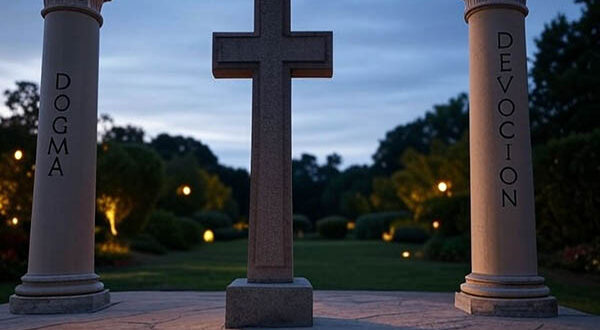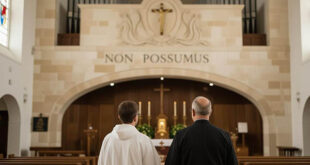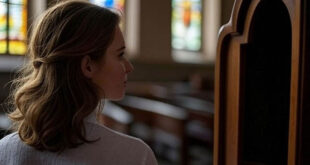Introduction: When the Heart Believes and Life Obeys
In an age marked by relativism, doctrinal confusion, and a loss of the transcendent, speaking about dogma may seem outdated, rigid, or even uncomfortable. However, far from being a straitjacket, dogma is the firm compass of the Christian soul, the anchor that keeps Peter’s boat steady amidst the waves of error. At the same time, devotion, often misunderstood as something merely sentimental or pious, is actually the living pulse of the believer, the concrete expression of the love born from truth.
Dogma and devotion are not opposites, nor even merely parallel: they are two deeply united dimensions of the same mystery of faith. What dogma teaches, devotion embraces; what devotion lives, dogma enlightens. This article delves into the history, theology, and spiritual practice of both concepts, with a current, accessible, and profoundly Catholic approach.
“For it is with the heart that one believes and is justified, and with the mouth that one confesses and is saved.”
(Romans 10:10)
1. What Is Dogma? Pillar of Revealed Truth
1.1 Theological definition
Dogma is a truth revealed by God, solemnly defined by the Magisterium of the Church, and proposed to the faithful as necessary for salvation. That is, it is not a matter of opinion or theory, but of fundamental truths that structure the Catholic faith. As stated by the First Vatican Council (1870):
“Dogmas are lights along the path of our faith, which illuminate and secure our walk amid darkness.”
Dogmas are like pillars of a spiritual building: if one is removed, the entire structure begins to tremble.
1.2 History of dogma: faith defined in times of crisis
Dogmas are not human inventions but precise expressions of revealed truth. They are defined when an essential truth of the faith is at risk:
- At the Council of Nicaea (325), the dogma of Christ’s divinity was proclaimed in response to the Arian heresy.
- At Ephesus (431), Mary was defined as Theotokos, Mother of God, to safeguard the true humanity and divinity of Christ.
- At the First Vatican Council, the dogma of papal infallibility was declared in matters of faith and morals.
Each dogma is, in a sense, a loving defense of Christ’s truth in the face of error, so that His sheep are not led astray.
2. What Is Devotion? The Love That Prays and Acts
2.1 A living definition
Devotion is the act by which the human will, moved by the love of God, surrenders with fervor, constancy, and humility in the service of faith. It is the loving response of the soul to the truths it believes.
Saint Francis de Sales said:
“Devotion is simply true love of God put into action.”
2.2 Forms of devotion in Catholic life
Devotions are manifested in many practices, all oriented toward growing in friendship with God:
- The Holy Rosary: meditation on the mystery of Christ through Mary.
- Eucharistic Adoration: being in the living presence of the Lord.
- Devotion to the Sacred Heart: symbol of divine love.
- Veneration of the saints: models of holiness and intercessors.
- Divine Mercy devotion, especially relevant in times of despair.
But caution: devotion without dogma becomes sentimentalism. That is why the Church has always united faith and love, truth and prayer, doctrine and life.
3. Why Are They Important Today? Theological and Pastoral Relevance
3.1 In times of confusion: firmness without fanaticism
Today, many confuse tolerance with indifference, and believe that “everything is fine as long as you’re a good person.” But without truth, love becomes disoriented.
Dogmas are not arbitrary impositions, but sure paths to God, given out of love. As St. John Paul II taught:
“To separate faith from dogma is to rip the soul out of religion.”
At the same time, living only from dogma without devotion dries up the soul. It becomes a cold, legalistic faith that does not burn with charity.
3.2 In practical life: living what you believe
A Catholic who knows the dogmas but does not pray is incomplete. And one who prays a lot but ignores what the Church teaches runs the risk of error or superstition.
Practical application for the reader:
- Study the Catechism of the Catholic Church: know what you believe.
- Pray with the content of the faith: let your devotion not be “empty.”
- Attend the Eucharist with doctrinal awareness: you are before the Body and Blood of Christ, not a symbol.
- Celebrate liturgical feasts understanding what they mean (the Immaculate Conception, for example, is not just “a Marian feast,” but the proclamation of a dogma in 1854).
4. How to Unite Dogma and Devotion in Daily Life
4.1 In the family
- Teach your children the truths of the Creed while praying the Rosary.
- Place sacred images in your home, not as decoration, but as an expression of living faith.
4.2 In the workplace
- Do not be afraid to profess the truth with charity when controversial topics arise (abortion, marriage, religious freedom).
- Pray briefly before starting your workday, offering your labor to God.
4.3 In the parish community
- Join doctrinal and prayer formation groups.
- Live the sacraments with informed faith: Confession, for example, is better understood when you know the dogma of original sin and sanctifying grace.
5. The Path of the Saint: Dogma Lived Through Devotion
The saints are the perfect synthesis of dogma and devotion:
- St. Athanasius, great defender of Trinitarian dogma, suffered exile for confessing the truth.
- St. Thérèse of the Child Jesus, with her simple devotion, lived intensely the doctrine of merciful love.
- St. Padre Pio, a profound knower of the faith, spent hours in confession and in prayer before the Blessed Sacrament.
The saints didn’t just know what they believed: they lived it to the fullest extent.
Conclusion: Dogma and Devotion, Two Wings to Fly Toward God
In a world where many want faith without commitment or spirituality without truth, the Church reminds us that true Catholicism is both dogmatic and devotional. One without the other does not lead to Christ, but to error or emptiness.
“God is spirit, and those who worship him must worship in spirit and truth.”
(John 4:24)
Dogma is the truth that saves, devotion is the love that responds. Let us not be afraid to delve into both, to teach them to our children, to live them with coherence. Now more than ever, the Church needs faithful who believe firmly and love fervently.
Final Spiritual Guide: How to Begin Today
- Pray the Creed daily, slowly, meditating on each phrase.
- Read the Catechism: begin with the first 50 points about faith.
- Choose a specific devotion (Rosary, Eucharist, a novena) and practice it with perseverance.
- Live the dogmas with concrete actions: the Incarnation calls you to respect all human life; the Resurrection calls you to live with hope.
- Always remember that to believe is also to love. Do not settle for a “light” faith: embrace the fullness of the Church’s treasure.
Do you want to strengthen your spiritual life and better understand what you believe? Then separate dogma from devotion no longer: unite them, live them, and you will be truly free.






